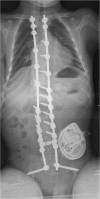Current concepts in neuromuscular scoliosis
- PMID: 30941730
- PMCID: PMC6542926
- DOI: 10.1007/s12178-019-09552-8
Current concepts in neuromuscular scoliosis
Abstract
Purpose of review: Spinal deformity is a common issue in pediatric patients with an underlying neurological diagnosis or syndrome. Management of neuromuscular scoliosis (NMS) is a major part of the orthopedic care of such patients, as the deformity is often progressive, and may affect gait, seating and positioning. In addition, untreated large spinal deformities may be associated with pain and/or cardiopulmonary issues over time.
Recent findings: Recent changes in medical management of the underlying disease process appears to alter the natural history of certain neuromuscular conditions, and in the case of patients with Duchenne's muscular dystrophy significantly diminish the incidence of spinal deformity. In the most common diagnosis associated with NMS, cerebral palsy, there is evidence that despite a high complication rate, surgical management of spinal deformity is associated with measurable improvements in validated health-related quality-of-life measures. Spinal deformity is a common finding in patients with neurological diagnoses. It is important for those involved in the care of these patients to understand the natural history of NMS, as well as the potential risks and benefits to the patient and caregivers, of surgical and non-surgical interventions.
Keywords: Caregiver/patient outcome studies; Cerebral palsy; Neuromuscular scoliosis.
Conflict of interest statement
Robert F. Murphy and James F. Mooney, III each declare no potential conflicts of interest.
Figures



References
-
- Fujak A, Raab W, Schuh A, Richter S, Forst R, Forst J. Natural course of scoliosis in proximal spinal muscular atrophy type II and IIIa: descriptive clinical study with retrospective data collection of 126 patients. BMC Musculoskelet Disord. 2013;14:283. doi: 10.1186/1471-2474-14-283. - DOI - PMC - PubMed
-
- Shapiro F, Zurakowski D, Bui T, Darras BT. Progression of spinal deformity in wheelchair-dependent patients with Duchenne muscular dystrophy who are not treated with steroids: coronal plane (scoliosis) and sagittal plane (kyphosis, lordosis) deformity. Bone Joint J. 2014;96-B:100–105. doi: 10.1302/0301-620X.96B1.32117. - DOI - PubMed
Publication types
LinkOut - more resources
Full Text Sources
Research Materials

